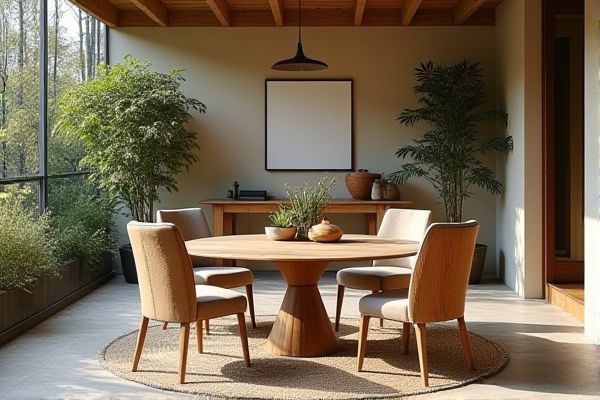
Round tables on a terrace promote easy conversation and maximize space efficiency, making them ideal for intimate gatherings. Square tables offer a modern aesthetic and can fit neatly into corners, providing structured seating arrangements; explore the rest of the article to discover which shape best suits Your outdoor space.
Table of Comparison
| Feature | Round Table (Terrace) | Square Table (Terrace) |
|---|---|---|
| Shape | Circular | Square |
| Seating Capacity | 4-6 people | 4 people |
| Space Efficiency | Better for tight spaces, flexible arrangement | Maximizes corner and edge placement |
| Interaction | Encourages equal interaction, easy conversation | Can limit interaction depending on seating |
| Style | Casual, modern, and social | Formal, structured, minimalist |
| Visual Appeal | Soft lines, harmonious look on terraces | Geometric, clean lines that define space |
| Placement | Works well in open areas | Fits corners and tight spaces better |
Introduction to Terrace Table Shapes
Terrace table shapes significantly impact outdoor space functionality and aesthetics, with round tables promoting social interaction through equal seating and a cohesive atmosphere. Square tables offer a structured layout that maximizes corner use and provides ample surface area for dining or workspace needs. Selecting between round and square terrace tables depends on space constraints, guest capacity, and desired ambiance.
Aesthetic Appeal: Round vs Square Designs
Round tables on terraces create a softer, more inviting aesthetic with their fluid curves that encourage social interaction and enhance visual harmony, while square tables offer a structured, modern look that complements minimalist and geometric outdoor spaces. The circular shape of round tables breaks the angular rigidity often found in terrace architecture, adding a dynamic contrast that balances natural and built elements. Square tables provide clear lines and defined edges that create a sense of order and formality, ideal for terraces featuring contemporary design or sharp architectural details.
Space Utilization on Terraces
Round tables optimize terrace space by allowing easier movement and access from all sides, reducing wasted corner areas compared to square tables. Square tables can fit snugly against walls or corners, maximizing seating capacity in narrow terraces but might limit flow and movement. Choosing between round and square depends on terrace dimensions and whether prioritizing free circulation or compact seating is more important.
Seating Capacity Comparison
Round tables typically offer more flexible seating arrangements, comfortably accommodating 4 to 8 people depending on size, making them ideal for intimate terrace gatherings. Square tables generally seat 4 people, with larger versions able to host up to 6, but they require more space per person due to their shape. Your choice between round and square terrace tables should consider how many guests you intend to seat and the spatial efficiency needed for your outdoor area.
Flow and Movement Around Tables
Round tables on terraces enhance flow and movement by eliminating sharp corners, allowing guests to navigate freely and comfortably. Square tables can create more defined boundaries, potentially restricting movement and reducing space for chairs. Your choice impacts social interaction and ease of circulation in outdoor settings.
Social Interaction Dynamics
Round tables on terraces foster equal conversation flow by eliminating head positions, encouraging inclusive social interaction and shared eye contact among all guests. Square tables create distinct sides that may promote subgroup clustering and more formal dialogue, affecting group cohesion. Opting for a round table enhances communal engagement and spontaneity during social gatherings.
Stability and Safety Considerations
Round tables on terraces offer enhanced stability due to their evenly distributed weight and absence of sharp corners, reducing the risk of tipping and injury. Square tables, while providing ample surface area, may present increased safety concerns because their corners can cause accidents, especially in tight outdoor spaces. Selecting heavy, weather-resistant materials further improves stability for both table shapes in terrace settings.
Maintenance and Cleaning Differences
Round terrace tables generally require less maintenance and easier cleaning due to their smooth, continuous edges that prevent debris accumulation in corners. Square terrace tables often trap dirt and leaves in their four corners, necessitating more frequent and detailed cleaning efforts. Your choice between these shapes can impact the time and effort spent keeping your terrace table pristine.
Suitability for Various Terrace Sizes
Round tables are ideal for smaller terraces, as their circular shape allows for more efficient use of limited space and easy movement around the table. Square tables suit medium to larger terraces, providing a structured layout that maximizes seating capacity without overcrowding. Your choice depends on the terrace dimensions and how you prioritize social interaction versus space utilization.
Choosing the Right Shape for Your Terrace
Choosing the right table shape for your terrace depends on space, functionality, and aesthetics. Round tables maximize seating flexibility and encourage conversation in smaller or irregular spaces, while square tables provide a structured layout, ideal for larger terraces with defined seating areas. Consider terrace dimensions and intended use to optimize comfort and flow.
 homyna.com
homyna.com